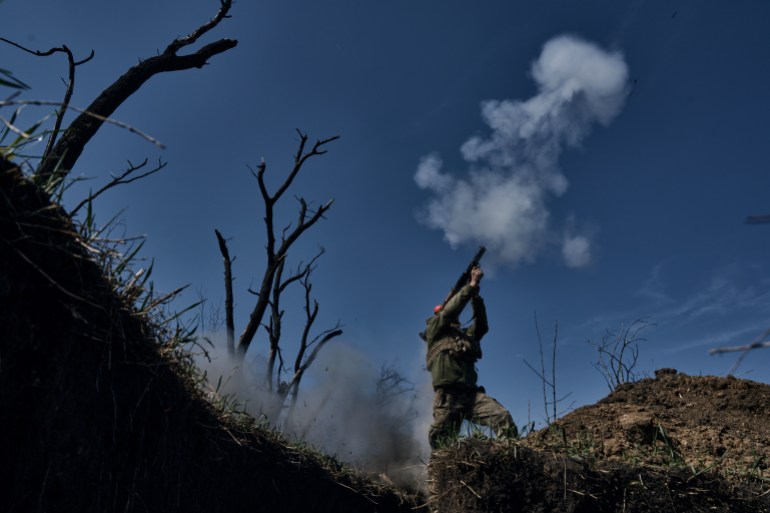A series of leaked reports purporting to be classified US intelligence documents linked to the war in Ukraine has drawn scepticism and denials from US spy agencies and several United States allies.
Photos of the classified files began circulating widely on Russian social media channels last week, but some were published on the gamers’ website Discord in February and March.
The CIA, NSA, and US Defense Intelligence Agency have denied the authenticity of the reports and have launched an investigation into the source of the leak.
The reports have also caused embarrassment for two US-Middle East allies—Egypt and the United Arab Emirates.
Egypt denied a Washington Post report citing a leaked document dated February 17 that said it had reached a secret agreement to supply Russia with 40,000 rockets, gunpowder and artillery shells.
“In the document, Sisi instructs the officials to keep the production and shipment of the rockets secret ‘to avoid problems with the West’”, the Washington Post reported, referring to Egyptian President Abdel Fattah el-Sisi.
A senior official told Al Qahera News the report was “informational tampering that has no basis in truth”.

Another leaked document focuses on the United Arab Emirates, saying Abu Dhabi had agreed to leak US and United Kingdom intelligence to curry favour with Russia.
“The UAE probably views engagement with Russian intelligence as an opportunity to strengthen growing ties between Abu Dhabi and Moscow and diversify intelligence partnerships amid concerns of US disengagement from the region,” the document cited by the Associated Press news agency says.
The UAE said suggestions it had deepened ties with Russian intelligence were “categorically false.”
Can Ukraine win?
More worryingly for the Western alliance backing Ukraine, some of the leaked documents suggest Kyiv is not set for a sweeping victory in its anticipated spring counteroffensive, and its air defences are vulnerable.
A purported US intelligence assessment from early February warned of “force generation and sustainment shortfalls,” and the likelihood of only “modest territorial gains”.
Ukraine has formed several new so-called storm brigades ahead of the counteroffensive and was advertising the formation of a seventh National Guard brigade, which would be the ninth “Offensive Guard” in the armed forces. A brigade typically consists of about 4,000 troops, suggesting that Ukraine had 32,000 offensive troops in reserve and was trying to raise that number closer to 40,000 ahead of the counteroffensive.
“Currently, we see a great demand and desire to join,” said Ukraine’s Interior Affairs Deputy Minister Kateryna Pavlichenko.
Following a telephone call with US Secretary of State Antony Blinken, Ukrainian Foreign Minister Dmytro Drunk tweeted on April 11, “@SecBlinken reaffirmed the ironclad US support and vehemently rejected any attempts to cast doubt on Ukraine’s capacity to win on the battlefield.”
A New York Times report quoted a leaked document predicting that ammunition for Ukraine’s Soviet-era air defence systems would soon be depleted, exposing the interior of the country to aerial attack.
“Stocks of missiles for Soviet-era S-300 and Buk air defense systems, which make up 89 percent of Ukraine’s protection against most fighter aircraft and some bombers, were projected to be fully depleted by May 3 and mid-April,” the newspaper said.

Ukraine says it is currently able to shoot down 75 percent of the missiles Russia sends, and is trying to convince its allies to send F-16s to bolster its air defences.
One of the documents claimed that Ukraine had suffered between 124,000 and 131,000 dead and wounded, five times higher than its official death toll.
Ukraine military intelligence spokesman Andriy Yusov said those reports were false or inaccurate. “We see false figures on losses from both sides. Part of the information is clearly collected from open sources,” he said in a telethon.
Russia ‘exhausted’ in Bakhmut
The bloodiest battles of the war continued to rage in the eastern city of Bakhmut, with Russia launching dozens of ground assaults there each day.
Ukrainian ground forces commander Oleksandr Syrskyi said Bakhmut’s defenders had “exhausted the Wagnerites,” referring to the Russian mercenary Wagner Group, “so the enemy is now forced to involve special forces and airborne assault units in the battles for Bakhmut”.
He said Russian forces had “switched to the so-called ‘Syrian’ scorched-earth tactics”, destroying buildings and positions with air strikes and artillery fire.
Ukraine’s general staff said Russian forces had suffered heavy losses in the Bakhmut area of Donetsk.
Ukraine has suffered significant losses in Bakhmut as well, and has justified its decision to defend the city as strategic.
“If we had not defended Bakhmut all this time, the enemy would have advanced deep into the territory of Ukraine, so the importance of defending the city must be understood in this context,” said Ukraine’s Deputy Defence Minister Hanna Malyar.

Although Ukrainian officials admitted Russian forces had a significant artillery advantage in the city, they were reportedly also running out of ammunition or conserving it.
“The pace of Russian attacks has decreased somewhat,” noted Colonel Oleksiy Dmytrashkivskyi, head of the joint press centre of the Defense Forces of the Tavria region.
“Over the past week, the enemy shelled our positions in the Zaporizhia and Donetsk directions 1,844 times. Compared to February, it is a third less.”
Russian forces have been trying to surround and choke off Ukrainian forces in Bakhmut. Serhiy Cherevatyi, spokesman for Ukraine’s eastern forces, said the destruction of a bridge to the village of Khromove, 2 kilometres (1.2 miles) west of Bakhmut, created a problem in supply lines the Ukrainian forces were working to overcome.
Ukraine’s general staff said Russian forces in occupied Kherson and Zaporizhia were evacuating people in anticipation of Ukraine’s spring counteroffensive.
“Russian occupants have activated preparation for the evacuation of local people to the temporarily occupied territorials of the Autonomous Republic of Crimea,” the general staff said. “In particular, in Melitopol and Skadovsk, the enemy organised a survey of local people for possible evacuation.”
Al Jazeera previously reported on satellite photographs showing Russian forces in Crimea digging themselves underground and preparing extensive defences.


